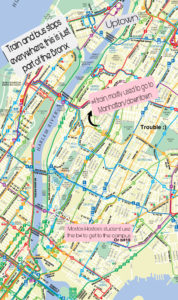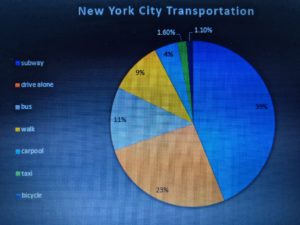
In a metropolitan or urban city, we have to get around. Specifically, here in New York City where the majority of people use public transportation to get from point A to point B. The convenience of public transportation is great, but not everyone can afford it. Particularly, those New York City residents who are low-income. For them, the fare should be free or at least reduce being that they have other expenses to pay for such as; food, shelter, utilities, electricity, gas, etc. Although the cost of a bus/train ride is 2.75, it adds up and that cost can exceed $100 a month, which puts low-income people into further economic strawn. Public Transportation is a system of transport by group travel systems available for use by the general public, typically managed on a schedule, operated on established routes, and charge a posted fee for each trip. This essay discusses research regarding the campaign and reasons why fares should be free or at least reduced for low-income New York City residents.
For some New Yorkers, 2.75 is a fair fare. Emma Fitzsimmons talks about the importance of increasing the fare every two years to use this money to solve the MTA crisis. According to Fitzsimmons, “transit leaders say they need billions of dollars to tackle huge budget ticket deficits and pay for critical repairs” (Fitzsimmons). In other words, it is said that the money collected from the fare is used for the own transportation benefits; subway repairs taking into account all the people who mostly use the train as transport, although the cost may increase in order to approve new revenue streams for the system. But we cannot dismiss the fact that transportation fares can have its advantages. As a benefit, “the bonus for pay-per-ride MetroCards will rise to 11 percent, from 5 percent, from anyone who puts at least 5.50 on a card…transportation advocates had argued that the bonus served an important function as a discount for low-income rides” (Fitzsimmons). This 11 percent may not seem like a lot but it could make a bit of a difference for low-income residents. Yet the bonus for the pay-per-ride MetroCards did not rise, however as a result of the Board to keep the 2.75 fares the 5 percent bonus was eliminated. And it is not to mention that there are reduced MetroCards for elders, in that case, the fare will only be $1.35. The 2.75 fares can be affordable for middle incomes and may be manageable for low-incomes who make an appropriate amount of money to hold their houses.
Now, considering someone who uses bus/train as a method of transportation to get to work, this person spend up to $100 monthly, this of course if this someone does not use both bus and train to get to their destination, in that case, it will be approximately $200 with the closest average of people that uses public transportation every day. Sterling Price, shows the average of money a household spends annually. It states that “20% of households regularly pay for some form of public transportation, about $225 per month” (Price). This is just the amount of money used for public transportation, money that can be used for some other expenditures. Being aware that for most low-income New Yorkers having 225 dollars monthly can be of good subsistence at the time to buy either food or pay bills. The Incorporation also claims that “for the average household, transportation costs are almost as much as what’s spent on rent or the direct costs of homeownership: an average of $2,000 annually” (Price). If we take into account, a low-income earn a minimum of $15,000 a year when there is just one household and a maximum of $39,500 if there is more than one, those $2,000 could be utilized for other needs. What I am trying to state is, while low-incomes spend around $4,000 on food, $2,100 on utilities, add $150 – $200 monthly= up to $2,000 annually for electricity and if you want plus $60 – $150= up to $1,200 on internet/cable or electronics (cellphones), with the $2,000 in transportation is already $11,300, almost what one household low-income makes a year. Even when it may be seen that it’s required to pay for the fare when it adds up it can become a reasonable amount for some residents who have other needs to address, but hey watch out because the ticket for not paying the fare is more expensive.
Sterling Price, shows the average of money a household spends annually. It states that “20% of households regularly pay for some form of public transportation, about $225 per month” (Price). This is just the amount of money used for public transportation, money that can be used for some other expenditures. Being aware that for most low-income New Yorkers having 225 dollars monthly can be of good subsistence at the time to buy either food or pay bills. The Incorporation also claims that “for the average household, transportation costs are almost as much as what’s spent on rent or the direct costs of homeownership: an average of $2,000 annually” (Price). If we take into account, a low-income earn a minimum of $15,000 a year when there is just one household and a maximum of $39,500 if there is more than one, those $2,000 could be utilized for other needs. What I am trying to state is, while low-incomes spend around $4,000 on food, $2,100 on utilities, add $150 – $200 monthly= up to $2,000 annually for electricity and if you want plus $60 – $150= up to $1,200 on internet/cable or electronics (cellphones), with the $2,000 in transportation is already $11,300, almost what one household low-income makes a year. Even when it may be seen that it’s required to pay for the fare when it adds up it can become a reasonable amount for some residents who have other needs to address, but hey watch out because the ticket for not paying the fare is more expensive.
Talking about the benefits of fair-fare or free fare, low-incomes have to take care of different needs in order to survive, having to pay the fare can put their economic stability in constant change whether they have to take bus/train to work. According to Evelly Jeanmarie a reporter of City Limits Youth Program, the number one problem of public transportation is fare evasion; people who skip the fare. She argues that in order to combat fare evasion the MTA should address the ride affordability: lowing fares for low-income rides or the use of half-priced MetroCards.
Residents in NYC have different reasons to beat the system either because they want to skip the fare or because they cannot afford it, making this a debate on whether the fare is reduced the fare evasion does not decrease. She also claims that there should be policies to allow free fares for poor people, and fair fares program could help achieve a free-fare system in NY. The campaign advocates that “many advocates have long held that the most effective way to combat fare evasion is to address its affordability: lowering fares for low-income riders who otherwise might be forced to jump the turnstile because they can’t afford to pay” (Jeanmarie). I agree that one of the reasons to not go Free-fare is because of fare evasion, yet as Jeanmarie says some of them can’t afford to pay it, people don’t always go around with change in their pockets and we never know if an emergency comes up and we got to run. A man’s word to develop the argument “When buses don’t really go faster than walking, at least a lot of the time, and when trains are just chronically delayed with little or no warning, it’s not surprising that people will take the opportunity if they see it to ride without paying” Kheel-Komanoff admits. What I am implying is whether people pay the fare or not as long as we are residents or low-incomes the fare should be free because nobody knows how your economic status is at the moment that even those $2.75 can be used to have breakfast, meal or dinner. Applebaum Stuart’s newspaper article emphasizes the idea of half-fare MetroCards for poor residents, the increase of transit fare is another challenge for working people of low income who have enough things to afford and transit expenses eats up 10 percent of poor families’ budgets. “Some made a proposal to the Community Service Society and the Riders Alliance for half-fare MetroCards for poor people” (Stuart #10). He argues that the eligible people for this half-fare plan will save up to $700 a year, a considerably large amount for low-income residents. This proposal has gained popular support in the US mostly in New York City, it has also gained support form News organizations including the New York Times and Daily News. This plan could help working-poor New Yorkers to move from low to the middle class if implemented.
Some people may say that $2.75 is a low price to pay for a ride that will take you from one city to another, yet the fact that there are people who do not make the same amount of money as other makes this topic controversial, is true that the average of people in NYC who evade the fare is about 16%, but like 5 percent of this people can not afford it. The amount of people who take public transportation in NY cities is bigger than the number of people who prefer to use their own cars, can’t forget that some people use public transportation even when they own a car because of the transit delays, and also some of the people are even unemployed; does not think about paying the fare when they don’t even have money for themself. It was not that long ago I was in the train and the seat next to me was empty because someone defecated in it, then this nice guy with the help of the other riders cleaned the sit, but the odor was still there, so with a pencil, a woman wrote on a paper “don’t sit someone du-du in here” funny right? then somebody else gave the guy tape so he could paste the note above, and I remember the guy after pasting the paper saying, “this is what New Yorkers have to deal with, but they don’t care about this when we have to pay the fare, transportation should be free for all residents man! we already have enough things to pay for” and I laughed because I thought “can you believe I am doing a research essay exactly about that? yeah… that is how the world works. As long as we are residents public transportation should be free for all of us.
Works Cited
Applebaum, Stuart. “Reduced Transit Fare Would Help Get Low-Wage Workers Moving.” New York, Amsterdam News, 2016, p. 10.
Evelly, Jeanmarie. “The Long-Shot Case for Making NYC Public Transit Free.” City Limits, 1 Feb. 2019, https://citylimits.org/2019/01/30/the-long-shot-case-for-making-nyc-public-transit-free/.
Fitzsimmons, Emma. “Subway Fares Are Rising Again. But That Won’t Solve the M.T.A.’s Crisis.’’ New York Times, 27 Feb 2019.
Fitzsimmons, Emma “M.T.A. Is Raising Fares and Tolls; One Subway or Bus Ride Will Cost $2.75” New York Times, 22 Jan 2105.
Price, Sterling. “Average Household Budget.” ValuePenguin, ValuePenguin, 12 Nov. 2019, https://www.valuepenguin.com/average-household-budget.
YouTube, YouTube, https://www.youtube.com/watch?v=ua3NTWlXOoQ.


